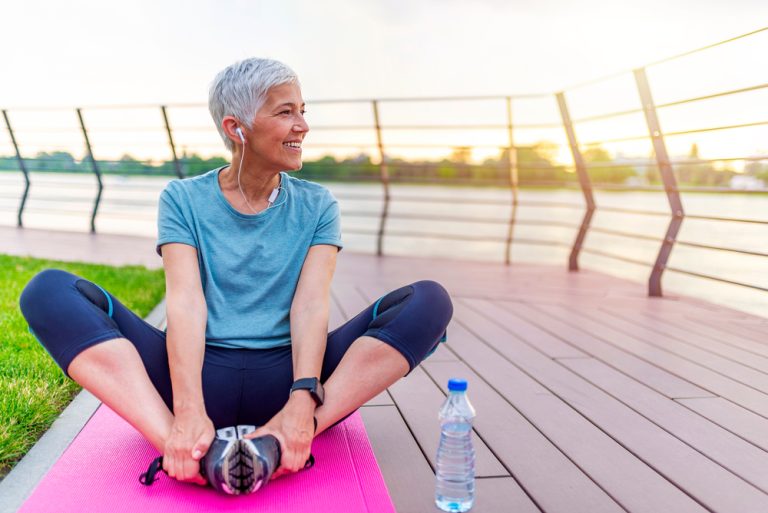
Senior flexibility: Why it’s important and how you can improve yours
We all know the feeling. That soreness and stiffness in our backs, hips, knees, and shoulders when we have been inactive for too long or have just gotten out of bed.
Sometimes the discomfort goes away as we move around; for others the stiffness lingers along with the pain, affecting our mobility. And that can make enjoying our everyday activities, well, a stretch.
But stretching exercises for seniors can improve our flexibility and strength, lessen pain and prevent injuries. Plus, it’s easy to incorporate simple stretches into your daily exercise routine. Let’s explore the importance of senior flexibility, and how to improve flexibility for seniors.
Why senior flexibility is important
So what is flexibility, exactly? And why is it so important to our overall health, especially as we get older?
To start with, flexibility is defined by physical therapists as the ability of a muscle or group of muscles to lengthen passively through a pain-free range of motion. In other words, it’s our ability to move our joints without restriction or pain.
Our degree of flexibility can dictate more than just how we feel when we get out of bed in the morning. It can actually help determine our overall quality of life, by either allowing us or preventing us from functioning normally.
Why we lose flexibility as we age
It’s normal to lose some flexibility as we age. Our muscles and tendons naturally lose elasticity, and our tissues and spines lose water. But losing too much flexibility can lead to increased risk of injury. You may notice even more muscle and joint pain. And you may simply stop doing the activities you enjoy because it hurts too much.
How to improve flexibility for seniors
You’ve probably heard the expressions, Use it or lose it, and If you rest, you rust. Both are true when it comes to staying active as you age. The cardinal rule is, Don’t stop moving!
But if you’ve lessened your amount of activity due to stiffness and pain, you CAN regain flexibility into your 60s, 70s, and beyond. It’s never too late to start stretching.
The key is to remember, movement is medicine. Start moving go for a walk, ride a stationary bicycle, do chair yoga, do arm windmills for 10 to 20 minutes a day, then gradually start adding 10 to 20 minutes to your movements. Try to mix up your exercises so you get movement in more parts of your body.
And whatever you choose to do, start with some good stretches.
Stretch exercises for seniors
There are two kinds of stretching: static and dynamic.
Static involves holding a stretch for 30 seconds or more, and focuses on lengthening a specific muscle or group of muscles. The stretch is always held steadily, without any bouncing or pushing or pulling.
Dynamic imitates real-world movements while also stretching your muscles and getting your blood pumping. It’s great for improving your range of motion because it focuses on stretching completely through a natural movement.
These six stretches incorporate both static and dynamic stretching.
Neck stretch
Sitting straight in a chair, lean your head to your left side and stretch your left arm over your head. Place your palm on the right side of your head. Add a bit of gentle resistance by pulling your head a slight bit. Hold for 20-30 seconds, repeat the movement to your right, then to the front and back.
Triceps stretch
While you’re in your chair, lift your right arm over your head, bending at your elbow. Grab your right elbow with your left arm and gently pull it, then hold for 20-30 seconds. Repeat with the other arm.
Ankle circles
While you’re sitting, extend one leg out in front of you. Rotate your ankle 10 times, first in a clockwise motion, then 10 times in a counter-clockwise motion. Lower your leg and repeat on the other ankle. Repeat two to three times for each ankle.
Seated hip stretch
As you’re seated, cross your left leg over your right leg so that your left ankle is resting on top of your right knee. Lean over your left knee; you should feel a stretch up the back of your left leg and into your back. For a deeper stretch, press gently down on your left knee as you lean over it. Switch legs and repeat.
Shoulder and upper back stretch
Stand up, with your feet about shoulder width apart and your arms at your sides. Pull your shoulders back and clasp your fingers behind your back. Start raising your arms up behind you. If you feel a stretch, stop there; if you can go higher, keep going, bending forward as you do, with your arms still clasped behind you. Repeat.
Quadriceps stretch
Balancing yourself on a sturdy chair or countertop with your left hand, slowly bend your right knee behind you and grasp your right ankle with your right hand. You may already feel a pull in the front of your thigh. Hold this stretch for 30 seconds, then switch legs. If you’re having trouble grasping your ankle, try using a resistance band. They look like giant rubber bands, color-coded based on the amount of resistance they provide.
Try Fellowship Senior Living’s virtual stretching regimen
Our on-demand fitness classes offer you several free exercise programs, including two great virtual classes on flexibility. Others are available on exercises from yoga to cardio workouts.
Fellowship Senior Living also has an experienced wellness and rehabilitation team on staff. They’re available to answer residents’ questions and create a personalized training program to help every resident to reach their personal wellness goals.
To learn more about our wellness program and our overall philosophy toward helping you live a healthier life, contact us.




